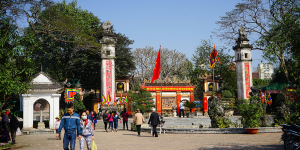
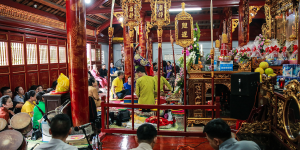
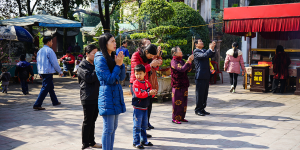
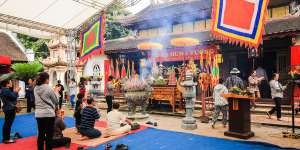
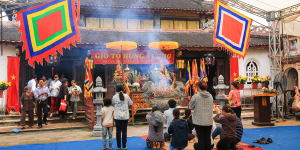
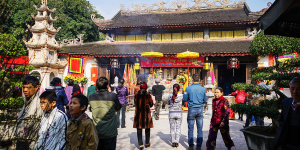
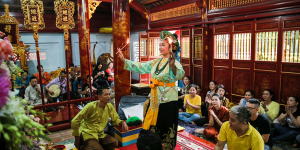
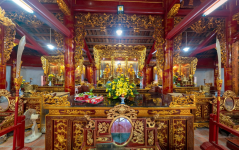
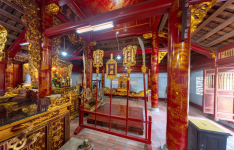
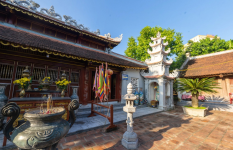
Camera tour
Price: Free
Time to visit a place: 120 phút
Open Time: 7:00 AM - Close Time: 6:00 PM
Address: Hong Son Sub-district, Vinh City, Nghe An Province
HONG SON TEMPLE
Located in the center of Vinh city, the relic of Hong Son temple is known to many people as an important point in the Nghe An travel itinerary, not only because of its unique scale and architecture, but also because of the sacredness of the strategic position as "the sacred land where the country's outstanding talents were born" of Nghe An province.
Hong Son temple (also known as Nha Ong temple or Vo Mieu) was built in 1839 during the 19th reign of King Minh Mang, to signify Van Mieu Nghe An. In the past, the temple was the place to worship Quan Van Truong, a famous martial artist of the Tam Quoc Era. After the war against the US, due to the damage of temples and pagodas in the area, this became the place of worship of Gods and Buddhas, creating richness and diversity according to the concept of "three religions including Confucianism, Buddhism and Taoism, merged into one" of Vietnamese people. Among the gods and Buddhas worshiped at the temple today, there are typically Hung Dao Dai Vuong Tran Quoc Tuan, Tran Binh Trong, Yet Kieu, and Tam Toa Thanh Mau.,...
The relic turns to the Southeast overlooking Con Moc river with 03 main works: lower hall, middle hall, upper hall, 02 left and right houses arranged oppositely, combined with many other auxiliary works such as poles, screens, bell towers, drum shelf, stele houses, semicircular lakes, dragon yards,... creating a majestic and ancient relic complex. The quintessence of architecture, which is also the highlight of the relic, are lower hall, middle hall and upper hall, this is the place that shows the most architectural details rich in aesthetics and arts, from the house with roof consisting of many layers of overlapping roofs, traditional curved roof corner to hip, edges, knife heads are decorated with patterns by four sacred animals and four kinds of trees. Each hall gives visitors a different feeling. The lower hall, from the system of columns, trusses, jacks, and ceilings, is painted with vibrant colors and decorated the shape of dragon phoenix in the style of royal architecture. The middle hall, at first glance like a gazebo, is a place where heaven and earth harmonize, embodying the full wishes of agricultural residents. At the middle hall, there is also a combination of royal style painting and carvings on wooden structures shown through the system of doors, veranda & porches, trusses with countless carved and inlaid pieces with the four sacred animals and four kinds of trees, creating a high, but gentle elegance. The upper hall is the forbidden palace of the gods, which is only opened on important occasions - the ancients did not pay attention to the architecture but focused on the depth of spirituality. Therefore, the architecture of this house is quite simple, only gently carved, but it is a place containing many historical and cultural values through the system of worshiping layout of the relic, which is the system of worshiping statues, thrones, tablets and ancient artifacts.
In addition to the scale and majestic and beautiful architecture, the temple also preserves many ancient and rare artifacts such as: stone stele, stone altar, bronze bell, worshiping statue, sacrifice items, ordinations... which are vivid evidences showing the tradition of a land as well as the existence of a cultural and spiritual address of Nghe An.
Every year, many unique cultural and spiritual activities take place at Hong Son temple, attracting a large number of people and tourists inside and outside the province, typically the Holy Mother's death anniversary on 3rd March of the lunar carlender, Saint Tran's death anniversary on 20th August of the lunar carlender...
With those values, Hong Son temple was ranked by Ministry of Culture and Information (now known as Ministry of Culture, Sports and Tourism) as a national historical - architectural and artistic relic in Decision No. 114/ QD-VH dated 30th August 1984.
Distance: 290 m
Distance: 540 m
Distance: 540 m
Distance: 1,000 m
Distance: 1,000 m
Distance: 1.19 km
Distance: 1.91 km
Distance: 1.98 km
Distance: 1.99 km
Distance: 2.01 km
Distance: 2.06 km
Distance: 2.12 km
Distance: 1.04 km
Distance: 1.21 km
Distance: 1.24 km
Distance: 1.33 km
Distance: 1.40 km
Distance: 1.55 km
Distance: 1.55 km
Distance: 1.66 km
Distance: 1.69 km
Distance: 1.74 km
Distance: 1.88 km
Distance: 1.95 km
Distance: 1.99 km
Distance: 2.21 km
Distance: 2.25 km
Distance: 2.28 km
Distance: 2.33 km
Distance: 2.52 km
Distance: 0 m
Distance: 40 m
Distance: 720 m
Distance: 800 m
Distance: 850 m
Distance: 870 m
Distance: 1.16 km
Distance: 1.31 km
Distance: 1.33 km
Distance: 1.40 km
Distance: 1.40 km
Distance: 1.59 km
Distance: 1.65 km
Distance: 1.69 km
Distance: 1.76 km
Distance: 1.77 km
Distance: 1.87 km
Distance: 1.88 km
Distance: 230 m
Distance: 820 m
Distance: 880 m
Distance: 1.26 km
Distance: 1.32 km
Distance: 1.44 km
Distance: 1.44 km
Distance: 1.50 km
Distance: 1.58 km
Distance: 1.67 km
Distance: 1.74 km
Distance: 1.81 km
Distance: 1.91 km
Distance: 1.93 km
Distance: 2 km
Distance: 2.18 km
Distance: 2.21 km


